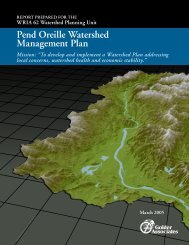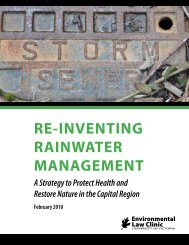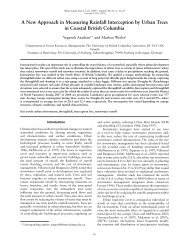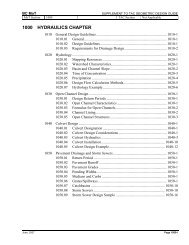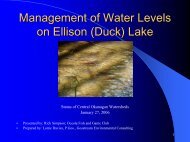Stormwater Source Control Design Guidelines 2005 - Waterbucket
Stormwater Source Control Design Guidelines 2005 - Waterbucket
Stormwater Source Control Design Guidelines 2005 - Waterbucket
You also want an ePaper? Increase the reach of your titles
YUMPU automatically turns print PDFs into web optimized ePapers that Google loves.
<strong>Stormwater</strong> <strong>Source</strong> <strong>Control</strong> <strong>Design</strong> <strong>Guidelines</strong> <strong>2005</strong>Pervious Paving<strong>Design</strong> <strong>Guidelines</strong> for Permeable InterlockingConcrete PavingPhoto Credit: Lanarc Consultants Ltd.Pervious pavement designs may be one of three types(Smith, 2001):- Full Infiltration – where all inflow is intended toinfiltrate into the underlying subsoil (See Drawing 4A).- Partial Infiltration – designed so that some water mayinfiltrate into the underlying soil while the remainder isdrained by perforated pipes (See Drawing 4B).- Partial Infiltration with Flow Restrictor – designed witha perforated pipe and flow restrictor located at thebottom of the drain rock reservoir. A small orifice inthe flow restrictor allows the gradual decanting ofwater above the perforated pipe, with infiltrationPervious paving reservoir base.occuring as much as possible. These systems areessentially underground detention systems, and areused in cases where the underlying soil has lowpermeability or there is high water table (See Drawing4C).<strong>Design</strong> <strong>Guidelines</strong> for all three types include the following:1. Soil subgrade sampling and analysis should be providedby a professional engineer knowledgable in the local soils.Testing of soil cores taken at the proposed area to bepaved should include soil texture classification, sampledmoisture content, 96 hour soaked California Bearing Ratio(CBR) with a target of at least 5% for light vehicular traffic,15% for heavy vehicles, and on-site infiltration tests using aDouble-Ring Infiltrometer taken at the elevation of theproposed base of the reservoir.2. Minimum recommended tested infiltration rate for a fullinfiltration pavement design is 12.5 mm/hr. Sites withlower rates will require partial infiltration solutions withdrain pipes, and care must be taken that the subbase willremain stable while saturated. (Smith, 2001)3. Where it is proposed to drain impermeable surfaces ontopervious pavement surfaces, it is recommended that amaximum ratio of 2:1 impermeable to permable is used(Formpave, 2003). This may vary by rainfall and soilcharacteristics as determined by modelling.4. Permeable Unit Pavers should be selected and designedbased on a manufacturer’s tests that the installed unitpaving system can maintain a minimum 28mm/hrinfiltration rate over the pavement life (usually 20 years).This rate includes a factor of safety of 10 – the initialinfiltration rate should be >280mm/hr (Smith, 2001).Greater Vancouver Sewerage & Drainage District55




